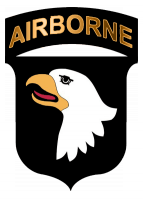 Fort Campbell, KY – In a historic moment for Army Aviation and the future of airborne warfare, the 101st Airborne Division (Air Assault) officially unveiled the Future Long Range Assault Aircraft (FLRAA) at Division Headquarters on Friday, June 6th, 2025.
Fort Campbell, KY – In a historic moment for Army Aviation and the future of airborne warfare, the 101st Airborne Division (Air Assault) officially unveiled the Future Long Range Assault Aircraft (FLRAA) at Division Headquarters on Friday, June 6th, 2025.
With military leaders, aviators, and defense industry partners gathered in anticipation, the ceremony marked a bold step toward redefining how the U.S. Army will fight and fly in the coming decades.
Brigadier General Travis McIntosh, Deputy Commanding General (Support) of the 101st, stood beside Doug Englen, retired Chief Warrant Officer 5 and now Bell’s Senior Military Sales and Strategy Manager, as they posed with Army Aviators in front of a detailed 1/8th scale model of the FLRAA—a sleek, state-of-the-art platform poised to revolutionize long-range air assault operations.
“The FLRAA is more than just a new aircraft—it’s a game-changer,” Brig. Gen. McIntosh told the crowd. “It will allow us to strike faster, reach farther, and dominate more complex battlefields with precision and speed. This is the future of vertical envelopment.”

Designed as a key component of the Army’s Long Range, Large Scale Air Assault (L2A2) strategy, the FLRAA is expected to replace the aging Black Hawk fleet and serve as the next workhorse of air assault units like the 101st. With its advanced speed, range, and survivability, the aircraft will significantly expand the Army’s ability to conduct deep insertion and rapid-response missions across contested environments.
Though what was unveiled was a scaled-down model, the energy in the room made it clear—this was no ordinary equipment briefing. For Fort Campbell’s aviation community, it was a glimpse into their mission’s evolution.
“We’ve spent our careers flying legacy aircraft that have carried the Army for decades,” said one attending aviator. “Seeing what’s coming next—it’s exciting. It feels like we’re stepping into a new era of air mobility.”

The FLRAA is slated to be officially fielded to the 101st Airborne Division in 2028, marking the beginning of a transformative chapter in Army aviation history. The unveiling not only symbolizes the Army’s modernization efforts but also reaffirms the 101st’s role at the cutting edge of combat innovation.
As the Screaming Eagles look toward 2028, the FLRAA stands as a striking symbol of what’s to come—longer reach, greater speed, and unmatched dominance from the skies.



